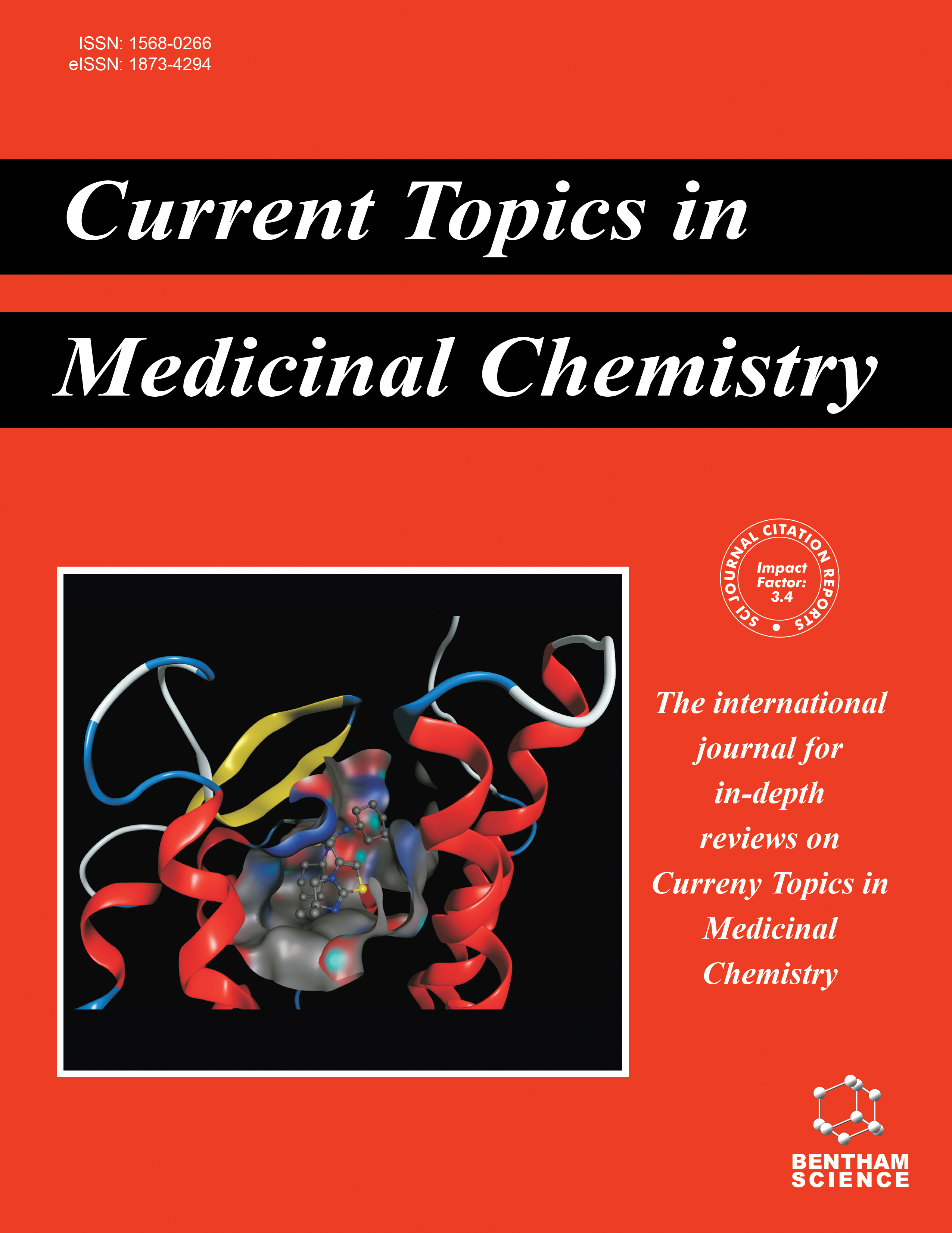- Home
- A-Z Publications
- Current Topics in Medicinal Chemistry
- Previous Issues
- Volume 12, Issue 3, 2012
Current Topics in Medicinal Chemistry - Volume 12, Issue 3, 2012
Volume 12, Issue 3, 2012
-
-
Editorial [Hot Topic: Metal Based Agents with Potential for Therapeutic and Diagnostic Applications (Guest Editors: Shigenobu Yano & Michael Gottschaldt)]
More LessAuthors: Shigenobu Yano and Michael GottschaldtMetal based agents are continuously gaining increasing attention as potential drug candidates or as tools in diagnostic applications. Combination of unique intrinsic properties of metal ions and complexes, e.g. redox-properties, radioactivity, magnetism or reactivity, with the multiplicity of various organic and bioorganic ligands afforded an inconceivable number of potential molecules. The known activities of several metal ions in bi Read More
-
-
-
Multifunctional Ligands in Medicinal Inorganic Chemistry- Current Trends and Future Directions
More LessAuthors: Linus Chiang, Michael R. Jones, Storr L. Ferreira and Tim T. StorrThis review will highlight recent advances in ligand design for innovative applications in medicinal inorganic chemistry. Ligands that effectively bind metal ions and also include specific features to enhance targeting, reporting, and overall efficacy are driving innovation in areas of disease diagnosis and therapy. Increasing the potency of therapeutic compounds, while limiting side-effects, is a common goal in medicinal che Read More
-
-
-
Development of Sugar-Based Materials for Biological Devices
More LessAuthors: Yuji Mikata and Shigenobu YanoRecent progresses of our group dealing with newly developed sugar-based ligands and their metal complexes have been reviewed. Carbohydrate moiety affects on the stereochemistry around the metal center and controls the biological activity of the complex.
-
-
-
Terpyridines and their Complexes with First Row Transition Metal Ions:Cytotoxicity, Nuclease Activity and Self-Assembly of Biomacromolecules
More LessAuthors: Andreas Winter, Michael Gottschaldt, George R. Newkome and Ulrich S. SchubertTransition metal complexes with terpyridine ligands have attracted a widespread interest with respect to biomedical applications: [(tpy)PtCl]Cl and [(tpy)RuCl3] are potent anti-tumor agents with activities comparable to those of cisplatin and carboplatin. The RuII complexes feature a high potential as reactive probes for DNA oxidation; whereas, luminescent IrIII, PtII or EuIII complexes have been utilized in biolabeling applic Read More
-
-
-
Improvement of Tumor Localization of Photosensitizers for Photodynamic Therapy and Its Application for Tumor Diagnosis
More LessAuthors: Shun-Ichiro Ogura, Yuichiro Hagiya, Kenji Tabata, Toshiaki Kamachi and Ichiro OkuraPhotodynamic therapy (PDT) and photodynamic diagnosis of cancer are widely used in clinical fields. These are performed using photosensitizers. Many metalloporphyrin-related compounds have been developed as photosensitizers for use in PDT, and these tumor localization ability have been improved in recent research. Moreover, the precursor of porphyrin 5-aminolevulinic acid is used in fluorescence diagnosis using its tumo Read More
-
-
-
What Does the Future Hold for Photo-Oxidizing RuII Complexes with Polyazaaromatic Ligands in Medicinal Chemistry?
More LessSince the discovery of cisplatin, the search for diagnostic or therapeutic agents based on other metals, has expanded intensively owing to the numerous possibilities offered by coordination chemistry. This mini-review focuses on recent advances in the search for RuII polyazaaromatic complexes of potential interest as molecular tools applied to cellular diagnostics or as specific cellular photo-reagents for future biomedi Read More
-
-
-
Therapeutic Potential of Photochemically Active Metal Complexes based on Interaction with Enzymes
More LessAuthors: Sven Rau and Shuaizhi ZhengTransition metal complexes with oligopyridine ligands and ruthenium or rhenium centers have attracted a widespread interest with respect to biomedical applications as they are luminescent and form triplet excited states which may form 1O2. These complexes have been shown to enter living cells and even cellular nuclei. In addition detailed investigations of their interaction with proteins/enzymes have shown that they ar Read More
-
-
-
Zinc Complexes Developed as Metallopharmaceutics for Treating Diabetes Mellitus based on the Bio-Medicinal Inorganic Chemistry
More LessAuthors: Yutaka Yoshikawa and Hiroyuki YasuiBiological trace metals such as iron, zinc, copper, and manganese are essential to life and health of humans, and the success of platinum drugs in the cancer chemotherapy has rapidly grown interest in developing inorganic pharmaceutical agents in medicinal chemistry, that is, medicinal inorganic chemistry, using essential elements and other biological trace metals. Transition metal complexes with unique chemical struct Read More
-
-
-
Next-Generation Anticancer Metallodrugs
More LessAuthors: Seiji Komeda and Angela CasiniMore than 99% of currently approved clinical drugs are organic compounds. In contrast, the percentage of metal-containing drugs (metallodrugs) is very low. In cancer chemotherapy, however, platinum coordination compounds represented by cisplatin and derivatives thereof are essential anticancer agents with proven effects against a variety of tumors. Because of the proven clinical applications of these platinum-based d Read More
-
Volumes & issues
-
Volume 25 (2025)
-
Volume 24 (2024)
-
Volume 23 (2023)
-
Volume 22 (2022)
-
Volume 21 (2021)
-
Volume 20 (2020)
-
Volume 19 (2019)
-
Volume 18 (2018)
-
Volume 17 (2017)
-
Volume 16 (2016)
-
Volume 15 (2015)
-
Volume 14 (2014)
-
Volume 13 (2013)
-
Volume 12 (2012)
-
Volume 11 (2011)
-
Volume 10 (2010)
-
Volume 9 (2009)
-
Volume 8 (2008)
-
Volume 7 (2007)
-
Volume 6 (2006)
-
Volume 5 (2005)
-
Volume 4 (2004)
-
Volume 3 (2003)
-
Volume 2 (2002)
-
Volume 1 (2001)
Most Read This Month
Article
content/journals/ctmc
Journal
10
5
false
en


